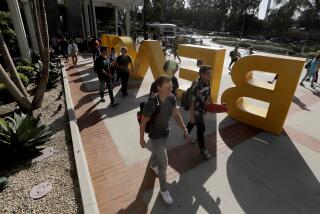Higher Learning: Cal State ‘success fees’ draw growing criticism
- Share via
Undergraduates in the California State University system already pay historically high tuitions: an average of $5,472 a year not including books, room and board.
But students who read the fine print are also noticing an additional charge — anywhere from $30 to nearly $800 a year — under the category of “student success fee.”
That money is going to cover budget gaps for such things as faculty hiring, more classes and technology upgrades.
Students are asking why they are being forced to pay more even as the economy and funding support for education are improving.
The answer has its roots in the recession, which significantly drained billions in state funding for Cal State and UC schools. Leaders at a dozen Cal State campuses approved the fees as a way to meet critical needs.
The fees — which are charged at 12 of Cal State’s 23 campuses — were enacted with little public attention.
But that is changing.
Officials had talked about expanding the charges at other Cal State schools, but that idea has been blocked for now.
At the behest of the state Legislature, Chancellor Timothy P. White is conducting a review of the fee policy, even as he approved the latest ones at three campuses.
The initial review found that although nearly half of students had some knowledge of the fees, only about 20% provided feedback before they were adopted.
No campus conducted a binding student vote, which according to the chancellor’s office is the “presumptive” method before a campus can institute a fee. Most relied instead on public information sessions, questionnaires, surveys and advisory votes — with varying degrees of success in obtaining student input.
Cal State campuses have long charged fees for health services, student government and other needs. But the “success fees” have drawn special attention because they are directed toward academic services. Those are typically covered under the annual tuition — which Cal State had pledged to hold steady under Gov. Jerry Brown’s budget plan.
Critics are most incensed that some “success fees” are going to athletics programs.
Cal Poly Pomona anthropology major Laura Hasbun said students should have been allowed to vote before her campus approved the fees, rather than merely filling out a survey. Hasbun said she would have used that money to pay for books and now she’s had to find a second job, reducing time for studies.
“My goal this year is to get this fee rolled back,” Hasbun, 19, said. “A lot of these things should be included in tuition.”
Many lawmakers apparently agree and the Legislature, as a part of the state’s final budget agreement, banned adoption of new success fees at other campuses until January 2016.
“There needs to be greater discussion about the process, more engagement by the Board of Trustees about how long these fees should last, and greater efforts to make sure the money is going where it’s supposed to,” said Assemblywoman Shirley Weber (D-San Diego), a member of the higher education committee who previously was a San Diego State professor.
Not everyone agrees that the fees are unnecessary. Some administrators and students welcome the additional revenues: Pomona extended library hours, added 125 classes and doubled the number of advisors, Provost Marten denBoer said. The annual fee of $306 is projected to raise more than $6 million this year and is overseen by several student-led committees, denBoer said.
Before it was adopted last year, more than 1,300 students on the 22,000-student campus completed a questionnaire, with 71% supporting the fee, the largest portion of which goes to athletics programs.
Plenty of money is at stake: The annual $346 per student fee at Cal State Long Beach generated more than $9 million in 2013-14, with about $2.3 million earmarked for academic improvements such as hiring more advisors and tutors; $2.6 million to update software, Wi-Fi access and other technology needs; and $2.4 million toward athletic scholarships.
Cal Poly San Luis Obispo, meanwhile, expects to generate nearly $15 million this year from the annual $780 fee — the system’s highest. It is one of the few campuses to conduct an advisory vote, with 57% of the 7,600 participating students approving the fee.
Twitter: @carlariveralat
More to Read
Sign up for Essential California
The most important California stories and recommendations in your inbox every morning.
You may occasionally receive promotional content from the Los Angeles Times.











